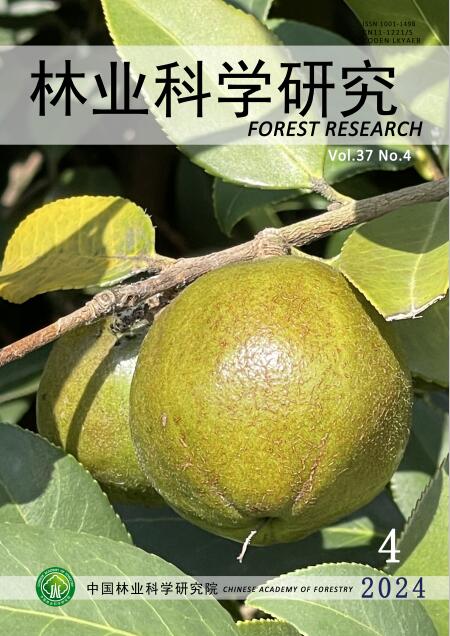干旱苗波生态系统土壤碳储量的遥感估算
Q4 Agricultural and Biological Sciences
引用次数: 6
摘要
Miombo干旱生态系统的总碳库常常被低估。本研究试图通过利用地面方法和遥感方法模拟地面上新鲜木质生物量碳库与土壤碳库之间的关系来缩小这一差距。在研究区内随机选取30个(30 m × 30 m)样地。树高和胸径(dbh)是本研究测量的植被特征。这些变量后来被用来计算每公顷地上新鲜生物量碳。在地块内的5个点随机采集土壤样本。对土壤样品进行土壤有机碳(SOC)分析。利用几何校正和辐射校正后的Landsat 8 Operational Land Imager (OLI)卫星影像,计算了3个遥感植被指数:比值植被指数(RVI)、归一化植被指数(NDVI)和土壤调整植被指数(SAVI)。利用相关回归分析定量分析了土壤有机碳、地上新鲜木质生物量碳与遥感植被指数之间的关系。结果表明,地上新鲜木质生物量碳与土壤有机碳在表层(0 ~ 15 cm)显著相关,深层(15 ~ 30 cm)不显著。地上新鲜木本生物量碳与土壤有机碳呈显著正相关,表明地上新鲜木本生物量碳可作为干旱苗波生态系统表层(0 ~ 15 cm)土壤有机碳的代用指标。遥感植被指数与土壤有机碳的相关性不显著(p>0.05)。这一结果表明,要将多光谱光学遥感作为估算Miombo干旱生态系统有机碳的工具,还需要进一步的工作。本文章由计算机程序翻译,如有差异,请以英文原文为准。
Estimating Soil Carbon Stocks in a Dry Miombo Ecosystem Using Remote Sensing
The total carbon pool in dry Miombo ecosystems is often underestimated. This study sought to close this gap by modelling the relationship between the above ground fresh woody biomass carbon pool and the soil carbon pool using both ground based methods and remote sensing methods. A total of thirty (30 m × 30 m) plots were randomly selected within the study area. Tree height and diameter at breast height (dbh) are the vegetation characteristics, which were measured in the present study. These variables were later used to calculate the above ground fresh biomass carbon per hectare. Soil samples were randomly collected from five points within the plots. The soil samples were analyzed for soil organic carbon (SOC). Three remotely sensed vegetation indices are-Ratio Vegetation Index (RVI), Normalized Difference Vegetation Index (NDVI), and the Soil Adjusted Vegetation Index (SAVI), which were calculated using geometrically and radiometrically corrected Landsat 8 Operational Land Imager (OLI) satellite images. Correlation and regression analysis were used to quantify the relationship between SOC, above ground fresh woody biomass carbon and remotely sensed vegetation indices. Results showed that, above ground fresh woody biomass carbon was significantly related to SOC in the top soil layer (0-15 cm) and not the deeper soil layer (15-30 cm). The significant positive relationship between above ground fresh woody biomass carbon and SOC suggests that, above ground fresh woody biomass carbon can be used as a proxy to estimate SOC in the top soil layer (0-15 cm) in dry Miombo ecosystems. Remotely sensed vegetation indices were not significantly (p>0.05) related to the SOC regardless of depth. This result implies that further work is needed before multi-spectral optical remote sensing can be used as a tool to estimate SOC in dry Miombo ecosystems.
求助全文
通过发布文献求助,成功后即可免费获取论文全文。
去求助
来源期刊

林业科学研究
Environmental Science-Ecology
CiteScore
0.90
自引率
0.00%
发文量
4834
期刊介绍:
Forestry Research is a comprehensive academic journal of forestry science organized by the Chinese Academy of Forestry. The main task is to reflect the latest research results, academic papers and research reports, scientific and technological developments and information on forestry science mainly organized by the Chinese Academy of Forestry, to promote academic exchanges at home and abroad, to carry out academic discussions, to flourish forestry science, and to better serve China's forestry construction.
The main contents are: forest seeds, seedling afforestation, forest plants, forest genetic breeding, tree physiology and biochemistry, forest insects, resource insects, forest pathology, forest microorganisms, forest birds and animals, forest soil, forest ecology, forest management, forest manager, forestry remote sensing, forestry biotechnology and other new technologies, new methods, and to increase the development strategy of forestry, the trend of development of disciplines, technology policies and strategies, etc., and to increase the forestry development strategy, the trend of development of disciplines, technology policies and strategies. It is suitable for scientists and technicians of forestry and related disciplines, teachers and students of colleges and universities, leaders and managers, and grassroots forestry workers.
 求助内容:
求助内容: 应助结果提醒方式:
应助结果提醒方式:


